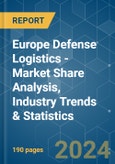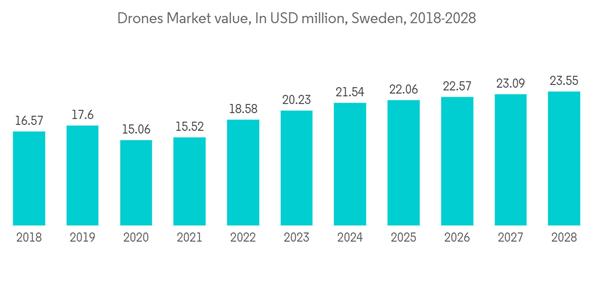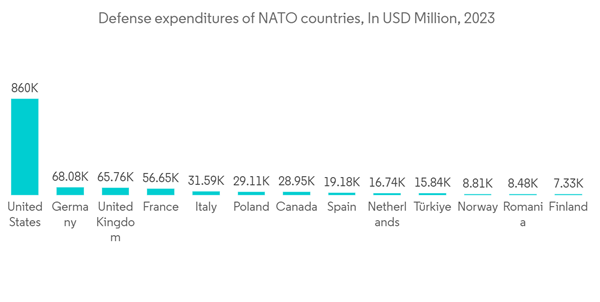The Europe Defense Logistics Market size is estimated at USD 29.27 billion in 2024, and is expected to reach USD 37.12 billion by 2029, growing at a CAGR of 4.87% during the forecast period (2024-2029).
Advanced defense technology includes that which permits space militarization, directed-energy weapons, and hypersonic flight, among other things.
The military can reduce soldier workload, defend forces, improve situational awareness, conduct search and rescue missions, and carry out other tasks thanks to the use of robotics and autonomous systems.
With the use of the Internet of Things, it is feasible to create a cohesive network out of soldiers, drones, ships, airplanes, and operating bases.
The military employs offensive cyber warfare in a variety of ways, including malware and phishing campaigns. The defense industry is also subjected to cyberattacks. Thus, one of its key areas of concentration is cyber protection, which may be accomplished by fusing cybersecurity, automation, and AI.
Real-time decision-making and battle training are improved by immersive technology like virtual and augmented reality. Defense equipment production costs can be brought down, new technical ideas can be implemented, and the logistical burden is reduced thanks to additive manufacturing.
Big data's quick and efficient data collecting, processing, dissemination, and ability to run simulations for better decision-making give the military a strategic edge. Instant situational awareness, improved training, and battlefield capabilities are all provided by 5G. Its quick speed, hyper-converged connection, secure data networks, and capacity to connect remote equipment to a combat network all contribute to this. Blockchain-based solutions are mostly used to defend against cyber threats and safeguard military data.
Infrastructure management LTG Infra will carry out military/civilian loading works at the Palemonas facility with European funding of EUR 13.27 million (USD 14.37 million) of the overall eligible cost of EUR 26.55 million (USD 28.75 million). Of the eligible cost of EUR 9.84 million (USD 10.65 million), EUR 4.9 million (USD 5.31 million) went to the Rail Baltica project for actions in Latvia involving the integration of military mobility requirements. A dual-use multimodal terminal and railway expansions will be built at the Portuguese port of Aveiro with funding provided by the Commission totaling EUR 7.6 million (USD 8.23 million) out of the qualifying cost of EUR 16 million (USD 17.32 million).
The CEF call for military mobility projects (MilMob) was announced in May 2022 with a budget of EUR 330 million (USD 357.31 million). However, the 63 projects requested a total investment of EUR 1.38 billion (USD 1.49 billion), exceeding the budget by more than EUR 1 billion (USD 1.08 billion). The project evaluation process finished in December 2022, when the projects chosen were announced. The projects that qualify in particular are those that facilitate cross-border transport, increase the capacity and connectivity of ports, increase multimodal traffic, and improve road and rail infrastructure so that trains can run longer and heavier.
This product will be delivered within 2 business days.
Key Highlights
- Since national security comes first, practically, they continued with all military procurement, maintenance, and logistics even while the world battled the COVID-19 outbreak. Additionally, the nationwide lockdown and supply chain irregularities are causing the logistics provider to experience a cash crisis.
- Businesses located in or dependent on supply chain operations from countries that were severely affected by the epidemic were the first victims of the disease. Technology companies put a greater emphasis on high-demand inventions and developed innovative methods of supporting their customers. However, the use of cooperative strategies by various military and logistic service providers to address supply chain-related problems helped to resolve the issue.
- In order to address the deteriorating security environment following Russia's aggression against Ukraine and to strengthen the EU's ability to protect its citizens and infrastructure, the Commission and the High Representative presented an Action Plan on Military Mobility 2.0 and a Joint Communication on an EU cyber defense policy.
- The Action Plan on Military Mobility will allow European military forces, in particular, to respond to crises that break out at the EU's external borders and elsewhere better, faster, and at a sufficient scale. It will improve the EU's capacity to assist Member States and allies with the transportation of troops and their supplies. It streamlines regulatory concerns while aiming for more connected and secure infrastructure. It will advance connection and communication with important partners and strengthen collaboration with NATO.
Europe Defense Logistics Market Trends
Use of advanced technologies in Military
For ISR (intelligence, surveillance, and reconnaissance) tasks, artificial intelligence aids computational thinking. Iterations of military products can be tested by defense producers thanks to digital twin technology and machine learning.Advanced defense technology includes that which permits space militarization, directed-energy weapons, and hypersonic flight, among other things.
The military can reduce soldier workload, defend forces, improve situational awareness, conduct search and rescue missions, and carry out other tasks thanks to the use of robotics and autonomous systems.
With the use of the Internet of Things, it is feasible to create a cohesive network out of soldiers, drones, ships, airplanes, and operating bases.
The military employs offensive cyber warfare in a variety of ways, including malware and phishing campaigns. The defense industry is also subjected to cyberattacks. Thus, one of its key areas of concentration is cyber protection, which may be accomplished by fusing cybersecurity, automation, and AI.
Real-time decision-making and battle training are improved by immersive technology like virtual and augmented reality. Defense equipment production costs can be brought down, new technical ideas can be implemented, and the logistical burden is reduced thanks to additive manufacturing.
Big data's quick and efficient data collecting, processing, dissemination, and ability to run simulations for better decision-making give the military a strategic edge. Instant situational awareness, improved training, and battlefield capabilities are all provided by 5G. Its quick speed, hyper-converged connection, secure data networks, and capacity to connect remote equipment to a combat network all contribute to this. Blockchain-based solutions are mostly used to defend against cyber threats and safeguard military data.
Increased Investments in Defense Logistics
The Hungarian Ministry of Transport will receive EUR 3.14 million (USD 3.40 million) from eligible costs of EUR 6.29 million (USD 6.81 million) for the adaptation of stations on the TEN-T's western side. Italy obtained EUR 3.87 million (USD 4.19 million) through the RFI for infrastructure improvement projects to accommodate 740 m trains in Pontedera and Palmanova stations, which had eligible costs of EUR 7.75 million (USD 8.39 million).Infrastructure management LTG Infra will carry out military/civilian loading works at the Palemonas facility with European funding of EUR 13.27 million (USD 14.37 million) of the overall eligible cost of EUR 26.55 million (USD 28.75 million). Of the eligible cost of EUR 9.84 million (USD 10.65 million), EUR 4.9 million (USD 5.31 million) went to the Rail Baltica project for actions in Latvia involving the integration of military mobility requirements. A dual-use multimodal terminal and railway expansions will be built at the Portuguese port of Aveiro with funding provided by the Commission totaling EUR 7.6 million (USD 8.23 million) out of the qualifying cost of EUR 16 million (USD 17.32 million).
The CEF call for military mobility projects (MilMob) was announced in May 2022 with a budget of EUR 330 million (USD 357.31 million). However, the 63 projects requested a total investment of EUR 1.38 billion (USD 1.49 billion), exceeding the budget by more than EUR 1 billion (USD 1.08 billion). The project evaluation process finished in December 2022, when the projects chosen were announced. The projects that qualify in particular are those that facilitate cross-border transport, increase the capacity and connectivity of ports, increase multimodal traffic, and improve road and rail infrastructure so that trains can run longer and heavier.
Europe Defense Logistics Industry Overview
The Europe Defense Logistics Market is fragmented. Several factors militate against the European defense industry’s collaborations, such as domestic procurement regimes organized to ensure privileged access for favored national firms. The EU member states prefer domestic companies. Hence, around 80% of their defense equipment is sourced domestically. In a pursuit to achieve strategic autonomy, the EU nations are required to tackle a considerable lack of interoperability among weapon systems and the wasteful inefficiency of defense investments.Additional Benefits:
- The market estimate (ME) sheet in Excel format
- 3 months of analyst support
This product will be delivered within 2 business days.
Table of Contents
1 INTRODUCTION
4 MARKET DYNAMICS
5 MARKET SEGMENTATION
6 COMPETITIVE LANDSCAPE
Methodology

LOADING...










